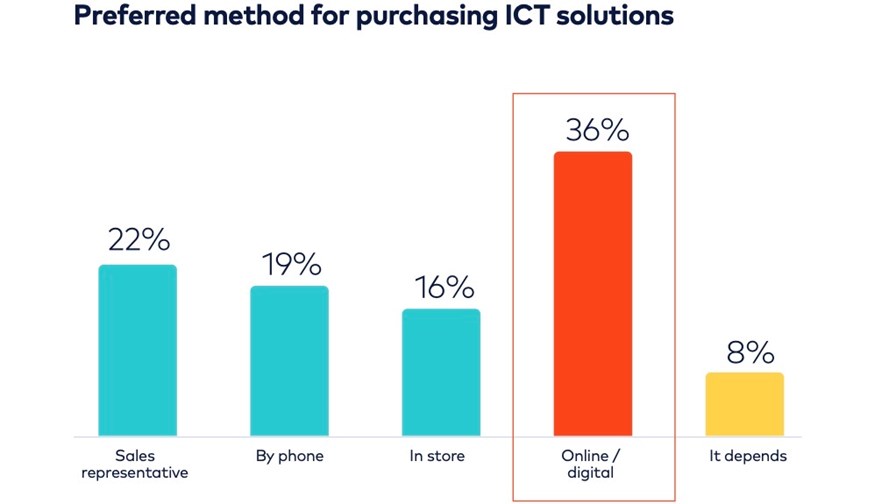
Source: Beyond Now report, 'CSPs: It’s time to reacquaint yourselves with today’s SMBs'.
- The SME market is a major achilles heel for telcos
- They have always courted small businesses but struggled to engage
- But we’re in a new digital era now – might that change things?
Small- and medium-sized enterprises/businesses (SME/Bs) are the lifeblood of economies, driving GDP, employing a high proportion of most countries’ working populations and, in turn, playing a key role in economic ecosystems as consumers of products and services. There are more than 400 million of them around the world. And like their larger peers, SMEs are undergoing what is generally referred to as a ‘digital transformation’, which can roughly be translated as a greater reliance on connected, near real-time and increasingly cloud-based platforms for operational and customer-facing activities.
And, of course, SMEs are, collectively, significant users of IT and communications (broadband and mobile) services, so much so in fact that research and consulting house Analysys Mason estimates that this year SMEs will spend $1.4tn on IT products and services and that this will increase at a compound annual growth rate (CAGR) of 7.5% for the next five years. “Cloud-based services will drive this growth because they support a distributed workforce, improve efficiency and provide business resiliency,” noted Analysys Mason in September, adding that “SMB IT spending on cloud-based categories is expected to grow from $600bn in 2022 to $1tn in 2027.”
Such statistics and forecasts should, in theory, have communications service providers (CSPs) licking their lips, as surely telcos are ideally placed to provide the fixed broadband and mobile connectivity that pretty much all SMEs need (with guaranteed levels of service) and then upsell all manner of services on top of those basics, right? The Analysys Mason team (a trusted source not prone to hyperbole) provides even greater hope for CPSs with its take on what SMEs want now and in the future. “Managed services, infrastructure and cyber security are key priorities for SMBs in 2022. Spending on these categories will account for 45% of SMBs’ total spending on IT. SMBs are shifting their focus towards categories that can help them to establish a resilient IT environment in order to enable business continuity and avoid future disruptions… Hybrid working environments will continue to drive spending on collaboration and business applications, as seen during the pandemic. SMBs will shift from using freemium versions to paid offerings within these category areas.”
Such demands and trends are tailor-made for the modern-day CSP, surely?
But in one way or another, this carrot on a stick has been eluding the telco donkey for decades. SMEs have always needed telecom services and CSPs have tried time and time again to devise go-to-market strategies for the SME market that would result in profitable sales growth, mostly without success. There are a few key reasons for this: Even though the sector includes companies with up to 250 employees, SMEs don’t have significant IT teams, and some don’t have any IT experts at all. Therefore, they need trusted and reliable professional services support from their suppliers, and for telcos to provide customer interaction and supporting services for SMEs, it would require a lot of human resources to support a lot of customers that don’t have massive communications and IT budgets (on average, an SME invests about 8% of its revenues in technology products and services).
For CSPs, traditionally, the economics of targeting and supporting the SME sector has been very difficult to stack up, which is why SMEs in general tend to run to local IT services companies/integrators that have the operational structure and specialist know-how to work effectively with the sector. That’s a massive generalisation, but one that appears to be a running theme for at least the past three decades as mobile services and then the cloud changed the comms and IT landscape for all types of enterprise users.
So are CSPs destined to always try but fail to truly crack the SME sector?
Maybe the current digital transformation era provides the best opportunity yet for telcos to actually become the go-to tech partner and supplier for SMEs… maybe.
The opportunity is staring them in the face, as digital platforms provide the obvious opportunity for CSPs to make the full range of their services available to SMEs on a self-service basis that would suit both parties. Much (though not all) of the required interaction and subsequent service delivery and configuration could be automated and SMEs could manage their IT service portfolios themselves through simple-to-use online portals without having to wait in a call queue to talk to someone who doesn’t know their account or business. On paper, the opportunity is fantastic.
Digital platform developer Beyond Now is one of the many companies that believes the time is now right for CSPs to finally crack the SME market and has conducted some research to see if small businesses are, indeed, as great an opportunity as they seem. Its research study is based on responses from 700 information and communication technology (ICT) decision-makers or key influencers at SMEs in North America, Europe and Asia Pacific, with the respondents equally represented from eight sectors: hospitality and leisure; professional services; agriculture; manufacturing; education; healthcare; retail; and technology, media and entertainment.
Of course, Beyond Now has a vested interest here – it wants the opportunity to exist and for CSPs and SMEs to invest in and use digital platforms. But the results of the survey, which have been published in a report, CSPs: It’s time to reacquaint yourselves with today’s SMBs, are illuminating nonetheless and the company does have first-hand experience of the scenario, as its technology underpins the digital SME services marketplace run by Japanese giant NTT Docomo.
It found that 85% of SMEs “recognise the importance of technology to the success of their businesses”, 51% rank technology as “very-to-crucially important”, and 68% want a single platform for technology solutions. And in the next 12 months, 70% of SMEs “believe that technology can help them achieve efficiency improvements and further digitalise their businesses, with some also exploring business growth, customer experience improvements, and easing issues caused by a lack of time and human resources.”
The research also found that SMEs are not just limited to cybersecurity and cloud services when they consider their technology options – the potential of blockchain, AI and robotics also resonates with this community, while the majority of respondents (73%) believe 5G can be beneficial and that CSPs can help unlock its potential. There are plenty of other statistics and conclusions cited in this announcement and in the full report.
More importantly, though, SMEs want technology to make their lives easier and more productive and they don’t want sourcing and managing their IT estate to be a hassle. According to the report, small businesses suffer “administrative headaches with having to manage multiple technology providers to meet their needs. 62% said there are gaps in off-the-shelf technology products in helping them to meet their business priorities. 64% want technology providers to work together to build joint solutions that help them achieve their goals. Critically for CSPs, 65% of SMBs would prefer to buy all their ICT from one source, and they would pay a premium for this. 33% would be willing to pay between one and five percent more, and 45% would pay between five and 10% more.”
And, increasingly, as the SME digital revolution takes hold, they want to engage with their suppliers via digital channels (see the chart above). Here’s a snippet from the report:
“Using digital channels [is] a prerequisite for CSPs who want to serve SMBs at scale. They give CSPs the ability to reduce cost of sales while serving such big and diverse segments. Often the first resistance will be the fact that SMBs rely heavily on assisted channels such as call centres and sales agents. However, this has changed at speed. SMBs today, like many other customers, are digitally native and digital is their first point of exploration… [digital is already the] SMBs’ preferred channel. 36% percent, or some 156 million SMBs worldwide, prefer purchasing ICT solutions digitally, and this is a number that will continue to grow.”
In 1990s marketing speak, this seems like low-hanging fruit for the CSPs. Beyond Now’s CEO, Angus Ward, certainly thinks so (though he isn’t so gauche as to use such a phrase).
“There is a rich vein of revenue available to CSPs if they can get their SMB value proposition right. That means building solutions around SMB needs, finding repeatable patterns and embracing digital channels that are key for developing viable business models. This involves creating a digital marketplace that can deliver the scale and automation necessary for CSPs to work with partners on delivering technology solutions that meet the diverse requirements of the SMB sector,” noted Ward, who, as we know, believes his company has the necessary platform to help.
But, of course, the CSPs are not the only ones with their eyes on this $1.4tn-plus prize because, as well as the local IT services firms, there are plenty of vertical industry specialists and cloud services players that will be looking to approach the market from their particular areas of expertise and bring in the CSPs as a minor and not particularly margin-friendly partner supplier of comms services. So, CSPs really do need to get their act together and transform themselves and the way they work if they are to capture this opportunity (and, indeed, remain relevant also to the broader enterprise services sector).
Here’s Ward again: “SMBs want to achieve business resilience through technology, and CSPs should be the ones to step up and help them. But SMBs are in a hurry and, traditionally, CSPs have not done enough to get to know their SMB customers. The result is that the clock is ticking for CSPs to become the SMB ICT provider of choice. It’s a lucrative segment, and CSPs that don’t act fast enough risk losing out to other players lining up to take on that same role.”
Quite frankly, it would be hard to argue that he’s wrong.
- Ray Le Maistre, Editorial Director, TelecomTV
Email Newsletters
Sign up to receive TelecomTV's top news and videos, plus exclusive subscriber-only content direct to your inbox.




